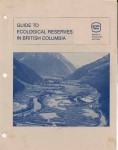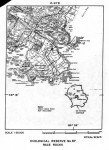Archives: The following is the Race Rocks section taken from the Guide, the complete version which is available on the Ecological Reserves website: ( 371 page guide):
http://ecoreserves.bc.ca/1992/11/15/guide-to-ecological-reserves-in-bc/
 |
 |
| Cover of the Guide to Ecological Reserves…1992 with the section on Race Rocks |
Map included of Race Rocks ER.#97 |
Main entry under title:
Guide to Ecological Reserves in British Columbia
Loose-leaf for updating.
Bibliography: p.
ISBN 0-7726-0733-8
1. Natural areas – British Columbia. 2. Research natural areas – British Columbia. I. British Columbia. Ecological Reserves Program. II. Title.
QH77.C3G84 1987
333.95’0971 1>C88-092006-8
The British Columbia Ecological Reserves Program, initiated in the late 1960’s, was formalized upon passage of the Ecological Reserves Act in 1971 and hiring of permanent staff to coordinate the program in 1974. The major objective of the program is to permanently set aside examples of both representative and unique ecosystems throughout the province. The reserves are intended to serve as natural benchmarks, research areas, outdoor classrooms and repositories of representative and rare genetic material.
This report is a descriptive catalog of those reserves set aside to date and is oriented primarily toward the interested public. Scientific terminology and detail have been reduced to a minimum. More detailed scientific reports concerning many reserves are on file at the BC Parks office in Victoria (Ecological Reserves Program, 1991).
The report is assembled in a binder format to allow for up-dating. Information on new ecological reserves or revisions to existing ones will be regularly produced and made available for insertion into the binder.
This report provides an introduction to the ecological reserves program by providing an overview of the evolution of the program; the objectives and benefits of ecological reserves; the administration and management of ecological reserves; and ecosystems and features protected within the ecological reserves system.
A descriptive text, including information about the primary purpose, as well as a map, are provided for each ecological reserve. A series of appendices are also provided which include the Ecological Reserve Act and Regulations, a summary description of the biogeoclimatic classification framework, lists of common and scientific names of vascular plants and a preliminary checklist of significant natural features found in the ecological reserves system.
For more information, please contact:
Ministry of Environment, Lands and ParksBC Parks
B.C. ECOLO6ICAL RESERVES PROORAM
PREFACE
CONTENTS
1.0 INTRODUCTION
1.1 What are Ecological Reserves?
1.1.1 Evolution of the B.C. Ecological Reserves Program
1.1.2Objectives and benefits
1.1.3Kinds of ecosystems included
1.1.4The selection and designation process
1.1.5Administration, management and protection
1.2 Current status of the program
1.2.1 Overview
1.2.2 Ecosystem representation
1.2.3 Unique and rare features
1.2.4 Research and education
1.3 About
1.3.1
1.3.2
1.3.3
this book
Sources of information
The descriptive text
Maps
- 1.4 References
2.0 LOCATION AND DESCRIPTION OF ECOLOGICAL RESERVES
2. 1 Alphabetical listing of reserves
2.2 Descriptive text and map for each reserve
3.0 APPENDICES
A. Ecological Reserve Act and Regulations
B. Description of biogeoclimatic zones
C. Representation of biogeoclimatic zones in British Columbia Ecological Reserves
D. List of common and scientific names of vascular plants referred to in reserve descriptions
E. A preliminary checklist of significant natural features found in Ecological Reserves in B.C.
TABLES
1. Location and description of B.C. Ecological Reserves
2. Alphabetical list of B.C. Ecological Reserves
FIGURES
1. Location of ecological reserves in British Columbia
2. Dr. Vladimir J. Krajina and the B.C. Ecological Reserves Program
3.. Protection of representative ecosystems in the Kingfisher Creek Ecological Reserve (#49)
4. Protection of genetic diversity in the Chasm Ecological Reserve (#65)
5. Protection of rare and endangered animal species in the Katherine Tye Ecological Reserve (#116)
6. Educational use of ecological reserves
7. Protection of rare plant communities in the Mount Maxwell Ecological Reserve (#37)
8. Protection of the rare and endangered Vancouver Island marmot in the Haley Lake Ecological Reserve (#117)
9. Big game research in the Gladys Lake Ecological Reserve (#68)
10. Forestry research in the Williams Creek Ecological Reserve (#114)
11. Protection of unique vegetation features in the Skwaha Lake Ecological Reserve (#88)
12. Research in seabird colonies
13. Protection of outstanding geological features in the Cardiff Mountain Ecological Reserve (#55)
14. Ecological reserve management
15. Volunteer Warden Program
16. The Duke of Edinburgh Ecological Reserve (#120)
17. Killer whales (Orcinus orca~ near the Robson Bight (Michael Bigg) Ecological Reserve (#111)
ECOLOGICAL RESERVES PROGRAM, 1992
RACE ROCKS
E.R. #97
PURPOSE: To protect intertidal and subtidal communities that are extremely rich as a result of strong tidal currents
LOCATION: In the Strait of Juan de Fuca, 17 km SW of Victoria, 1.5 km off the extreme southern tip of Vancouver Island
SIZE: 220 ha LAT: 48 18N LONG: 123 32’W
ELEVATION: -36.5 to 10 m
BIOGEOCLIMATIC ZONE: Coastal Douglas Fir
PHYSICAL FEATURES:
The reserve is almost entirely subtidal, but includes seven or eight islets comprising, in total, less than 1 ha. Intertidal and subtidal zones have substrates primarily of Continuous rock, and a rugged topography which includes cliffs, chasms, benches and surge channels— The location at the southern tip of Vancouver islands, plus the rugged shallow seabottom, result in strong currents, eddies, and turbulence.
BIOTIC FEATURES:
Energy and nutrient inputs attributable to the nearly Continuous currents are large, and light penetration in these shallow, clear waters is excellent. These factors result in a high production of algae and invertebrates, while the varied topography promotes ecological diversity. Consequently, the marine communities here are unusually luxuriant and rich. Twenty two species of algae have been recorded, including extensive stands of bull kelp. Invertebrate features include long surviving specimens of mussels, an abundance of plumose and proliferating anemones, large numbers of sponges and ascidians, occurrence of soft pink coral, and presence of showy high—current species like the basket star.
Marine mammals sighted in the reserve are the killer and gray whale, harbour seal, Steller and Cahfornia sea lion, elephant seal, and fur seal. Up to 60 different killer whales are regular visitors; the gray whale is spotted occassionally. About 300 harbour seals haul out on rocks here in summer. In recent years 35—70 Steller and up to 800 California sea lions have used Race Rocks as a winter haul—out.
Seabirds nest on seven rocks in the reserve, and on Great Race Rock which is excluded. Including the latter island, about 235 pairs of pelagic cormorants, 180 pairs of glaucous-winged gulls, 80 pairs of pigeon guillemots, and four pairs of black oystercatchers are present.
OUTSTANDING FEATURES: Highly productive and diverse subtidal life in an area of high demand by researchers, educators, and recreational divers.
OTHER INFORMATION: Order-in-Council no. 692, 27 March 1980. Application no. 315. Map no. 92 B/S. Marine chart no. 3641. Accessible only by boat, but no sheltered moorage is available. Diving conditions are frequently dangerous. An important teaching site for Lester Pearson College.
B.C. ECOLOGICAL RESERVES PROGRAM
(c/Eco) 87-04—30
